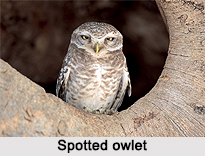 Spotted Owlet is an Indian Bird of owl family that bears a scientific name "Athene brama" is a small owl which breeds in tropical Asia from India to Southeast Asia.
Spotted Owlet is an Indian Bird of owl family that bears a scientific name "Athene brama" is a small owl which breeds in tropical Asia from India to Southeast Asia.
Behaviour and Habitats of Spotted Owlet
Spotted Owlet is a common resident of open habitats including farmland and human habitation, it has adapted to living in cities. They roost in small groups in the hollows of trees or in cavities in rocks or buildings. It nests in a hole in a tree or building, laying 3-5 eggs.
Concentration of Spotted Owlet
Spotted Owlet is absent from Sri Lanka, although the birds are found across the Palk Straits, just 30 kilometres away at Rameshwaram . Nests near human habitations may show higher breeding success due to increased availability of rodents for feeding young. The species shows great variation including variation in size and forms a super species with the very similar little owl.
Structure of Spotted Owlet
Spotted Owlet is small and stocky. The upperparts are grey-brown, heavily spotted with white. The under parts are white, streaked with brown. The facial disc is pale and the iris is yellow. There is a white neckband and supercilium. Sexes are similar. The flight is deeply undulating. The nominate form is darker than the paler forms such as indica of drier regions.
Species of Spotted Owlet
The two Spotted Owlets have been separated but they are considered to form a super species complex. The five species of Spotted owlet are widely recognized subspecies of western Asia in Iran and Pakistan and of northern India; brama of southern India which is darker than indica owl. The northern and southern Indian populations intergrade and there is no dividing boundary. The northern indica populations of Spotted Owlet have the upperparts brownish. Size decreases from north to south. The species is not found in Sri Lanka, although birds on the Indian mainland are found even at the tip of Rameshwaram
Sounds of Spotted Owlet
The call of Spotted Owlet is a harsh and loud churring and chuckling chirurr-chirurr-chirurr ending with a chirwak-chirwak and they call mainly during early dawn or just after sunset.
Breeding Season of Spotted Owlet
The breeding season of Spotted Owlet is November to April. The courtship behaviour includes bill grasping, allopreening and ritual feeding. The female may call with the male, bob head and deflect its tail in invitation. The social organization of family groups is not clear and multiple males may copulate with a female and females may attempt pseudocopulation, possibly a kind of displacement behaviour. They nest in cavities often competing with other hole-nesters such as mynas. They may also nest in holes in vertical embankments. The nest may be lined with leaves and feathers or may use the existing lining from a prior occupant. The typical clutch is made up of three or four spherical white eggs and incubation begins with the first laid eggs leading to a wide variation in the size of the chicks. The young are fed initially on insects such as cockroaches and later fed small vertebrate prey such as mice. The chicks gain weight during the early stages but lose weight before fledging. Only one or two chicks may fledge and they leave the nest in about 20-28 days.
Brain of Spotted Owlet
The brain of Spotted Owlet has a pineal gland, a feature formerly thought to be absent in the owls. Birds show variation in the melatonin concentration between day and night. A high melatonin level is associated with sleep and low levels are associated with high alertness and foraging activity. Spotted owlets, however, show only a slightly lower melatonin concentration at night with a slight increase in the early afternoon. Other owls such as the barn owl show little day-night variation. Seasonal changes in glandular activity have been associated with environmental factors such as temperature and humidity.











